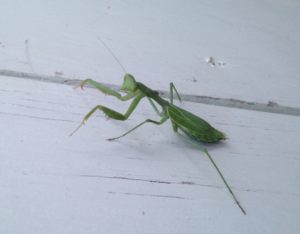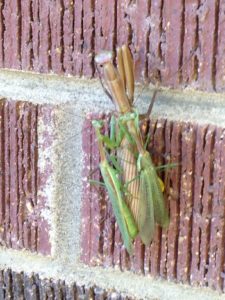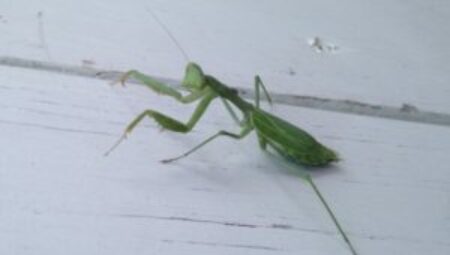Our ‘Spiritual’ Insect Friend, the Praying Mantis
While walking around Hawkins Preserve in Cortez on a recent morning I happened upon an insect that is letting itself be seen more this time of year. I managed to carefully scoop her (or him) up in my hand while she seemed to look at me with curiosity, and took a good look at her perfect little insect body.
The praying mantis is thus named because of the interesting way it holds its front two legs, looking like they are in a praying position. The word ‘mantis’ actually comes from the Greek ‘mantikos’, meaning prophet. There are over 2,000 species of praying mantids in the world, but only a certain portion of these are actually from the genus ‘mantis’; thus praying ‘mantid’ is usually more correct. Their front legs are used to snag insect prey, and although the mantis may be sold in some garden stores as a beneficial insect, it doesn’t actually discriminate between eating harmful and eating beneficial insects. It will eat a beneficial honeybee just as likely as it will eat a damaging caterpillar.
The praying mantis is also known for its two large compound eyes, adding to its ‘alien-like’ appearance. Less well known, however, are the three simple eyes found between the compound eyes on its triangle-shaped head. The two large eyes enable the mantis to have stereoscopic vision, one of only two insects in the world that have this. The praying mantis is the only insect able to turn its head 180 degrees. Some, but not all, praying mantises have wings. Some praying mantises have one ear, located on their abdomen. It doesn’t hear most sounds very well with this ear, but it is actually able to hear high-pitched bat echolocation ‘peeps’. This enables the mantis to evade bats that are trying to get a midnight snack.
 Praying mantises mate in the late summer/early fall, and yes, the rumors are true – the female will sometimes either eat her mate after mating or will even bite his head off in the middle of the act (and the body will finish the job without the head). Although this is much more common in captive mantises than in the wild. Some scientists estimate that wild mantises only cannibalize their mates 25% of the time. Incidentally, since starting to write this article about a week ago, I’ve seen 5 praying mantises in the wild; however, the fourth and fifth ones were a female who at first glance seemed to be holding her mate in her arms lovingly… but in actuality she was enjoying munching on his head! The picture on the left shows a female mantis apparently with 2 mates?!
Praying mantises mate in the late summer/early fall, and yes, the rumors are true – the female will sometimes either eat her mate after mating or will even bite his head off in the middle of the act (and the body will finish the job without the head). Although this is much more common in captive mantises than in the wild. Some scientists estimate that wild mantises only cannibalize their mates 25% of the time. Incidentally, since starting to write this article about a week ago, I’ve seen 5 praying mantises in the wild; however, the fourth and fifth ones were a female who at first glance seemed to be holding her mate in her arms lovingly… but in actuality she was enjoying munching on his head! The picture on the left shows a female mantis apparently with 2 mates?!
A female praying mantis found in the fall may be looking for a location to lay her egg cases called oothecae. She will lay perhaps hundreds of eggs in each ootheca, which initially looks rather soft and foamy, but eventually dries up, looking more like brown styrofoam. The young stay and grow in this case until spring or early summer when they all hatch out at once! The young nymphs that hatch look just like smaller versions of the adults. As the nymphs grow, they will periodically shed their exoskeleton, having a softer exoskeleton that forms underneath, and eventually hardens. They will do this 6 – 9 times before becoming an adult size.
Despite being predators in the insect world, praying mantises are also preyed upon. Spiders, ants, frogs, lizards, and birds are all predators of the praying mantis. Their main defense is camouflage, and some blend in very well – mimicking flowers, leaves, and sticks in their habitat.
Seeing a praying mantis can be considered to be good luck or bad, depending on your culture. Because of the ‘praying’ hands, some Christians say that the praying mantis represents spiritualism or piety, and if found in your home, may mean that angels are watching over you. Some Muslims say that the praying mantis is always facing towards Mecca. However, in Italy, some believe that if a praying mantis looks at you menacingly, it can make you sick, and in Japan, it may even be a foretelling of your death. Personally, I feel lucky any time I get to see one of these amazing insects, and can’t wait to see more.
Falling Leaves: What’s Happening to the Trees?
Autumn is a beautiful time to be in the mountains, on public lands. The reds, yellows, and oranges we see in a land where we’re used to seeing greens and browns can be breathtaking. What are the environmental cues that are making this yearly phenomenon happen? And where does this color come from?
Why do Trees Lose Their Leaves?
In the Northern Hemisphere, autumn is generally known to occur during September, October and November. Our signals include fewer daylight hours and falling temperatures, not to mention other environmental cues such as birds migrating south or to lower elevations, our gardens finishing up their harvest, and of course, the changing colors and eventual drop-off of the leaves.
Why do trees lose their leaves every year? Doesn’t it take a lot of energy to make new leaves every spring? In fact, it takes plenty of energy for trees not to lose their leaves every year. Of course, some trees already do this – coniferous, or evergreen trees. Examples of these trees in our area include pines, spruce and firs. Coniferous tree leaves, also sometimes called needles (depending on the tree), must be specially adapted to deal with even the coldest winters. One of the main ways they are adapted to this is by being tough. Their leaves are tough and strong, as well as have many chemicals in them that aren’t very tasty to insects. Therefore they can ‘afford’ not to lose their leaves every year.
Deciduous trees that do lose their leaves every year do this for some very good reasons. For one, their leaves are just not adapted to survive the freezing temperatures of winter – they are much too delicate for that. Another reason is that by dropping their leaves they are getting rid of leaf-eating insects and their eggs and larvae. In fact, producing new leaves every spring is relatively ‘cheap’ for trees to do, considering what they get in return – the trees get to lose the old leaves that may have been damaged by weather, disease and insects, and are able to produce fresh, new leaves that can make food for the tree via photosynthesis.
What is it that makes the leaves drop? Tree trunks, branches and twigs can survive the winter, but delicate leaves aren’t so lucky. At the end of summer, the leaves are filled with sugar. At the base of each leaf is something called a separation layer. In the fall, the cells in this layer start to fill up with a cork-like substance, trapping the sugar in the leaves. Once this happens, water also cannot get to the leaves. The combination of this and the lack of sunlight makes the chlorophyll start to break down. Eventually the leaves fall from the trees, breaking off at this separation layer. Oak leaves are one exception to this, however. In oak leaves the separation layer never fully ‘separates’ the leaves from the twigs, and the leaves often stay on the tree all winter.
The Color of Things
For a good portion of the year, trees in our area are green. The green pigment in the cells of the leaves is chlorophyll. This chlorophyll is what allows the trees to be able to make food for the tree in the form of sugar. As the days get shorter, daylight is diminished and there is not enough light for photosynthesis to occur. The chlorophyll that was already in the leaves then begins to break down, and additional chlorophyll is no longer being produced, making the green fade from the leaves. Through the winter, trees rest from their food-making processes and live off the food that has been stored in the twigs and branches throughout the summer.
As the green fades from the leaves, orange and yellow appears. These pigments, called carotenoids, were actually always present in the leaves – we just couldn’t see them before because they were covered up by the green chlorophyll. Anthocyanins are the pigments that cause us to see red leaves. Anthocyanins are actually only made in the fall. This occurs because sugars are trapped in the leaves after photosynthesis stops. Not all trees make anthocyanins. It’s not clear why some trees do expend the energy to make anthocyanins. Some scientists believe it’s because it allows the trees to keep their leaves a little longer, allowing the nutrients in the leaves to go back into the tree for longer. Others think it’s because after the leaves fall on the ground and decay, it prevents other plants from growing and competing with the tree. The brown color that some leaves turn to is a result of wastes that are left in the leaves after the chlorophyll is gone.
It is speculated that the best fall colors appear when the spring has been wet, summer has been dry, and autumn has bright, sunny days and cool nights.

